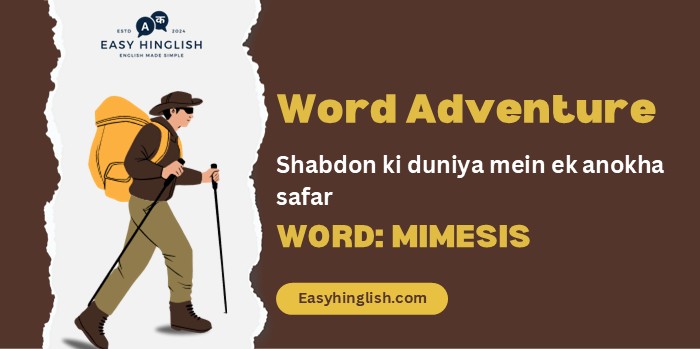Word Adventure: Mimesis
The Headline
“Mimesis: Kaise Imitation Ban Gayi Western Art Aur Thought Ki Foundation”
The Scoop
Ideas ke vast landscape mein jo have shaped human culture, kuch concepts prove karte hain so fundamental ki woh influence karte hain our understanding across disciplines aur centuries. ‘Mimesis’ ek aisa powerful idea hai – ek term jo explores the relationship between art aur reality, between representation aur truth. Let’s journey from ancient Greece to modern times, tracing how ye concept has informed our understanding of creativity, learning, aur human impulse to imitate aur represent the world around us.
Let’s Break It Down
The Plot Thickens
‘Mimesis’ enter hua philosophical discourse mein ancient Greece mein, most notably through writings of Plato aur Aristotle, though unke contrasting views the iske value par. Plato was somewhat suspicious of mimesis, arguing in “The Republic” ki art imitates physical reality, jo itself is merely imitation of ideal Forms – making art ek copy of copy, twice removed from truth. Aristotle, however, dekha mimesis ko more positively in his “Poetics,” viewing artistic imitation as natural human instinct aur valuable way to gain knowledge aur catharsis.
Through centuries, ye concept evolve hua across different traditions aur disciplines. Literary theory mein, mimesis refers to way texts represent reality, in contrast to “diegesis” (telling ya narration). Sociology mein, mimetic behavior describe karta hai how humans learn through imitation. Biology mein, mimicry refers to how some species evolve to resemble others for survival advantage.
Jo cheez makes mimesis particularly fascinating ye hai ki how ye sits at intersection of art, philosophy, psychology, aur biology – suggesting ki imitation isn’t just artistic technique but fundamental aspect of how humans understand aur navigate reality. Renaissance painters se jo strived for perfect verisimilitude to modern debates about virtual reality, questions about representation aur reality continue to resonate with this ancient concept.
Word in the Wild
The Twist
Yahan hai thought-provoking dimension of mimesis jo often goes unexplored: ye concept has come full circle in our digital age, raising fascinating questions about representation aur reality. Consider kijiye how social media ne create kiya hai strange new form of mimesis – people carefully crafting representations of their lives jo others then imitate karte hain, creating hall-of-mirrors effect jahan line between authentic living aur performance blur ho jaati hai. Similarly, technologies like deepfakes aur AI-generated art challenge our traditional understanding of mimesis by creating imitations jo have no original in physical reality. Ye contemporary twist would likely fascinate ancient Greeks jo first pondered this concept – because ab hum not just creating art jo imitates life, but increasingly living lives jo imitate art, with algorithms mediating both processes. Perhaps most interesting question isn’t whether art imitates life ya life imitates art, but what happens jab woh distinction itself becomes impossible to maintain.
Make It Stick
Mimesis: Jahan mirror meets imagination, aur reality gets creative remix!
Your Turn
Think kijiye work of art, literature, ya film ke baare mein jo aapko particularly compelling laga in its representation of reality. Kya made it feel “true” despite being creative work? Conversely, kya aap recall kar sakte hain time jab art jo deliberately broke from realistic representation (like abstract painting ya experimental fiction) revealed something meaningful about reality? Share kijiye apne thoughts comments mein below. Let’s explore karte hain how mimesis shapes our expectations aur experiences of both art aur life!
Down the Rabbit Hole
- Curious about philosophical perspectives on mimesis? Explore kijiye Plato’s “Republic” (Book X), Aristotle’s “Poetics,” ya Erich Auerbach’s landmark study “Mimesis: The Representation of Reality in Western Literature.”
- Interested in how mimesis functions in different art forms? Research kijiye “realism” in painting, “method acting” in theater, ya “cinéma vérité” in film.
- Want to understand mimetic behavior in human development? Look into studies on mirror neurons, childhood imitative learning, ya cultural anthropologist René Girard’s “mimetic theory” of desire.
The Last Word
Jaise hum conclude kar rahe hain humara exploration of ‘mimesis’, main hope karta hun ki aapne gain kiya hai appreciation for is ancient concept jo continues to shape how we understand art, representation, aur human nature itself. Plato ke concerns about imitation se lekar contemporary questions about virtual reality aur artificial intelligence tak, mimesis remains fundamental lens through which hum examine karte hain relationship between reality aur our creative attempts to capture, transform, aur sometimes transcend it. Next time jab aap find karenge yourself captivated by particularly realistic novel ya questioning authenticity of social media presentation, remember kijiye ki aap engage kar rahe hain with questions of mimesis jo have fascinated thinkers for over two thousand years. Until our next word adventure, ye hai Prashant from Wordpandit, encouraging you to look twice at the imitations aur representations jo surround us every day!








